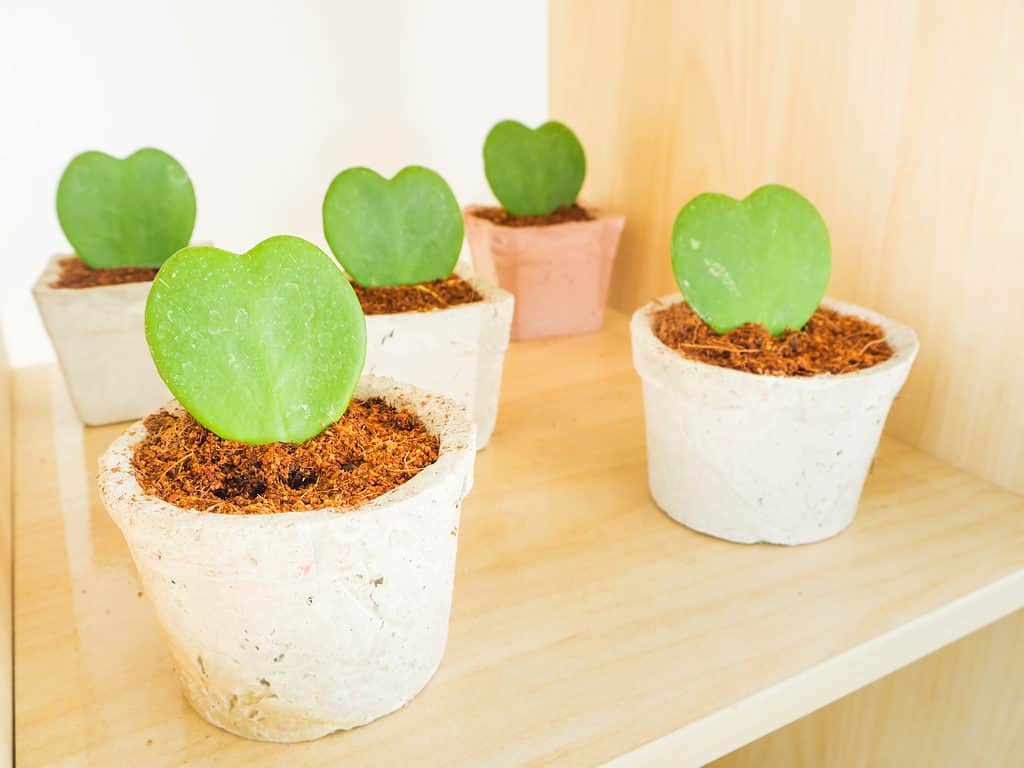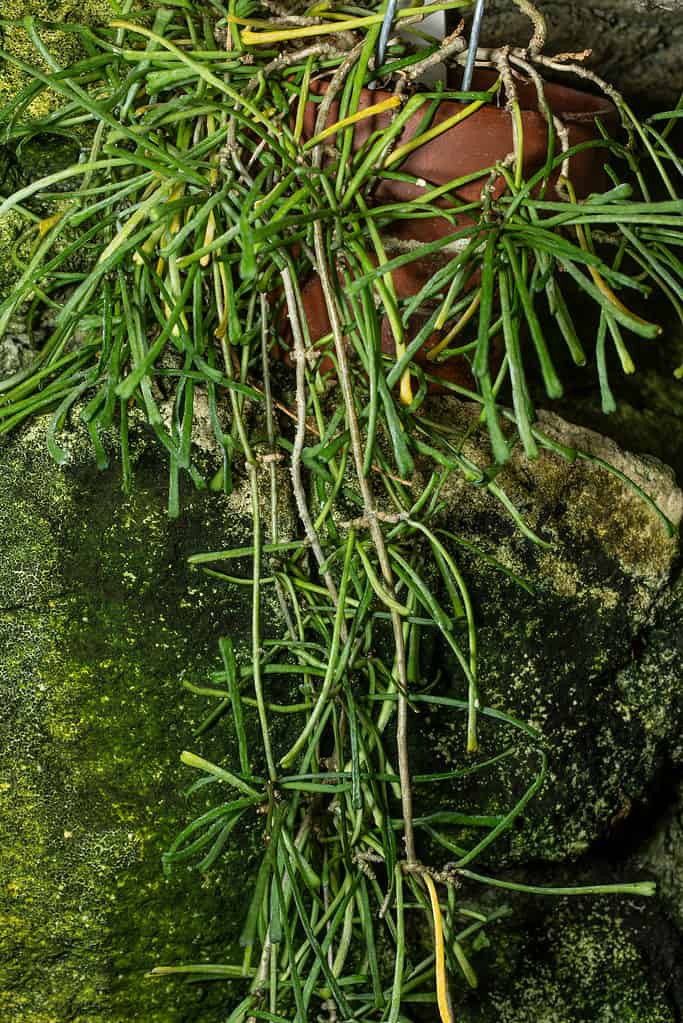Have you wanted to expand your hoya collection but aren’t quite ready to invest in new houseplants yet? Don’t worry. This particular tropical plant is incredibly easy to propagate, making it the ideal starter for hoya enthusiasts. Propagation offers two wonderful benefits. First, it is a cost-effective way to expand any plant collection. But perhaps most importantly, the process provides an opportunity to learn more about the plant’s growth and care. Are you ready to start your own propagation journey? Keep reading to learn different methods for propagating hoya plants and a few additional tips for success.
Stem Cuttings
One of the most popular methods for propagating hoya plants is through stem cuttings. And it is no wonder why, stem-cutting propagation is about as easy as it gets. Start by finding a stem on a healthy parent plant that is at least 4-6 inches long and has several leaves.
Using a clean, sharp pair of scissors or pruning shears, cut the stem at a 45-degree angle, just below a node. Nodes are small bumps on the stem that produce flower buds or leaves. Make sure the cutting includes one or two nodes.
Remove most of the lower leaves from the stem cutting, but retain one or two leaves at the top. If the plant doesn’t have to worry about directing energy toward leaf growth and development, it can conserve energy while it establishes roots.
Gently dip the cut end of the stem in rooting hormone powder. Most garden centers will carry this powder. While propagation via stem cuttings may succeed without the hormone powder, its addition will help stimulate root growth. So, adding this step will help you see success more quickly.
Select a small container or pot for the cutting and fill it with a well-draining potting mix, such as peat moss, perlite, and vermiculite. Another option is to pick up one made for cacti and succulents, which will be naturally loose. Create a small hole in the soil and gently insert the cutting. Bury it up to the first node.
Water the soil lightly, being careful not to overwater. Keep the soil slightly moist but not saturated. Then, place the pot in a warm, bright location, out of direct sunlight. Just like the parent plant, direct sunlight can damage your hoya stem cutting.
Keep a close eye on the soil to ensure it stays moist. After a few weeks have passed, gently tug on the stem. The goal is to determine whether roots have started to develop. Once they have, feel free to transplant the cutting to a larger pot.

Choose a stem from a healthy plant with multiple leaves and nodes.
©Kazakov Maksim/Shutterstock.com
Leaf Cuttings
Another propagation method is to use leaf cuttings. However, this method is best for species of hoya plants with fleshy, succulent leaves. Select a healthy leaf from a mature plant for the best chance at success. Use a clean, sharp pair of scissors to remove the leaf at the base of the stem.
Using the same clean shears, cut the leaf into multiple sections. Make sure that each one has at least one vein, preferably two. The new root systems will develop through those veins.
Dip the cut ends into rooting hormone powder, as discussed above. The potting technique is similar to what gets used for stem cuttings. But you will bury the cut edge of each leaf section into the soil. Ensure each vein gets buried shallowly in the soil.
Gently water the soil. You want to use caution and keep the soil moist but not waterlogged. If the soil gets too saturated, the leaf-cutting will get damaged and won’t develop a new root system.
The next step is crucial for successful propagation using the leaf-cutting method. Cover the pot with a plastic bag or wrap to create a nice, humid environment to encourage root growth.
Set the pot in a warm and bright area, keeping it out of direct sunlight. Pay close attention for a few weeks to make sure the soil remains moist.
Once new root systems develop (which may take a few weeks), transplant your new hoyas into their own pots.

Sweetheart hoyas are typically propagated using leaf cuttings.
©Supachita Krerkkaiwan/Shutterstock.com
Layering
Layering allows you to propagate a new hoya while still attached to the parent plant. It is an ideal method for trailing or vining hoya plants.
Find a healthy and flexible stem on the parent plant. You want the stem to bend without breaking. Use a clean knife or shears to make a small cut on the underside of the stem below a node. Then bend the stem down into the soil surface of a separate pot. Secure it in place with a U-shaped wire or a small piece of bent wire. The wounded section of the stem should remain in contact with the soil.
Cover the wounded section of the stem with a handful of moist potting mix to protect it. Water the soil around its edges and place the pots in a warm, bright location. As a reminder, your hoys need to stay out of direct sun.
After a few weeks pass, tug on the stem to see if roots have formed. Once they have, you can cut the stem below the new root system.
Division
If your hoya plant has gotten quite large, you may consider division as a propagation method. This process separates the parent plant into smaller sections. Division is best for large, mature plants with multiple stems.
Before dividing your hoya plant, gently remove it from the pot. Then carefully separate the roots and stems into smaller sections. You can do this with a clean, sharp knife, pruning shears, or your hands.
Check each section to ensure they have several healthy stems and roots. Gather multiple pots and fill them with a well-draining potting mix, like that used for succulents and cacti. Each section should get its own pot.
Use caution when watering to avoid adding too much. Hoyas prefer their soil to be relatively dry and are prone to root rot. Set each pot in a location that receives bright, indirect sunlight. Keep a close eye on the soil to monitor the moisture level. Within a few weeks, the new plants should start to grow.
Propagation Tips
While propagation is a fun and rewarding way to expand your hoya plant collection, the process requires time, patience, and care. Here are a few tips to help ensure success:
- Use clean, sharp tools to take cuttings or divide plants. Doing so will help prevent damage or infection to your parent plant.
- Use a well-draining potting mix. Hoyas are prone to root rot, and the last thing you want is to lose all your new baby plants.
- Keep the soil moist but avoid overwatering.
- Keep your new plants in a location that receives bright but indirect sunlight.
- Roots may take several weeks to develop, so patience is key.
- If you choose to add a plastic bag or wrap to help create a humid environment, remove it periodically to prevent mold or fungus growth.
Propagation is the way to go if you want to add one or more hoyas to your collection. Not only will you learn more about your plants, but you can spruce up your home or office with stunning hoya vines. Everyone prefers a slightly different propagation method. But the great thing about hoyas is that they are responsive and easygoing. So whichever method you choose will work well. Hoyas do require patience, though. So take your time, give them proper care, and enjoy the experience.

Propagating hoyas allows you to grow your collection affordably.
©K Hanley CHDPhoto/Shutterstock.com
The photo featured at the top of this post is © Focus-Bokeh/Shutterstock.com
Thank you for reading! Have some feedback for us? Contact the AZ Animals editorial team.







